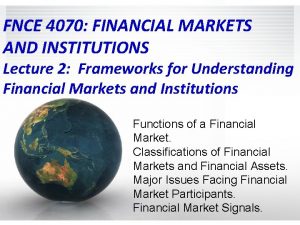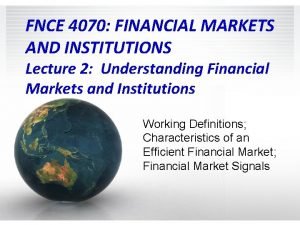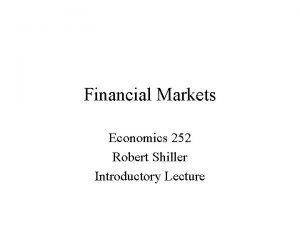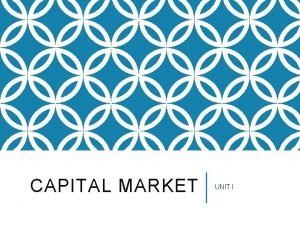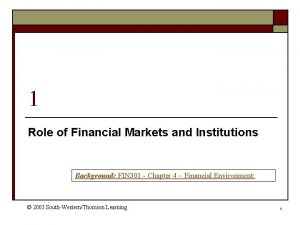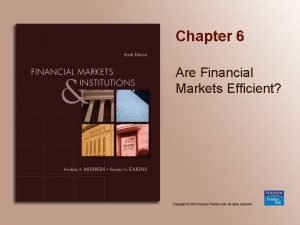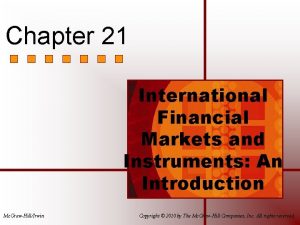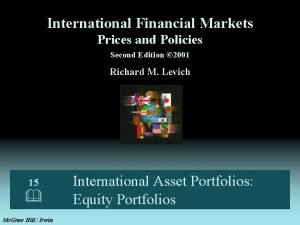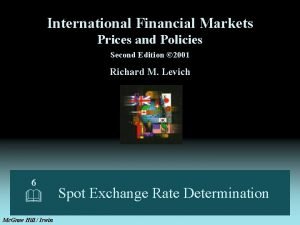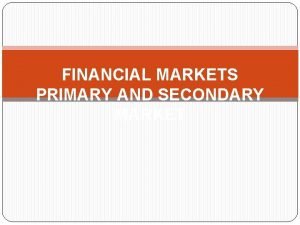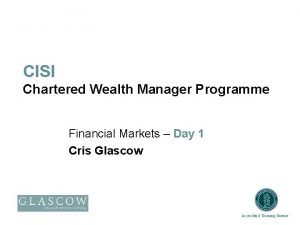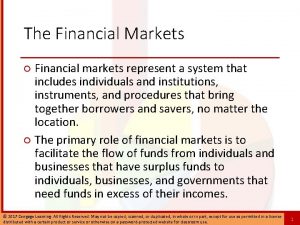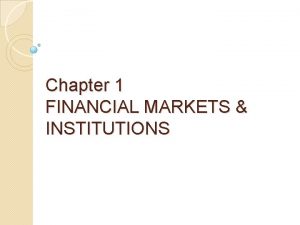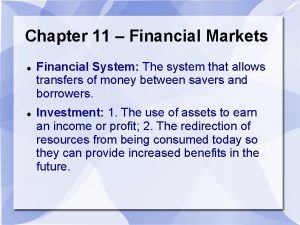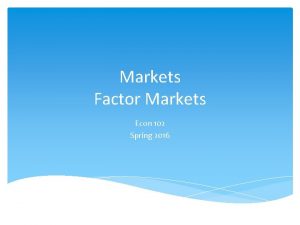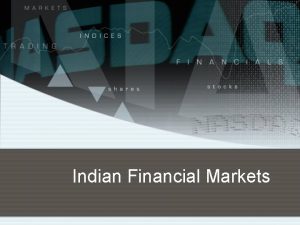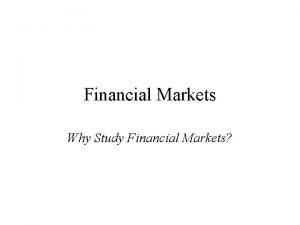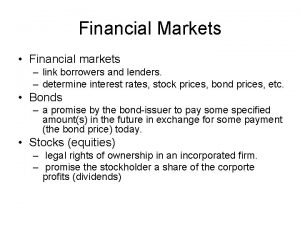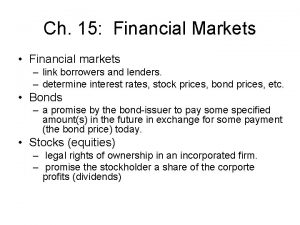Financial Markets Chapter 12 The Financial System Financial

















- Slides: 17

Financial Markets Chapter 12

The Financial System • Financial system = savers, investors, and institutions that work together to transfer savings to investors. • You can save in different ways: – 1) open a savings account – 2) buy a certificate of deposit (CD) - a loan to a bank that earns interest – 3) government bonds

• Financial intermediaries = institutions that lend funds that savers provide to borrowers – They include: • • • Banks Savings & Loans Credit unions Life insurance companies Pension funds

Nonbank Financial Intermediaries • Finance company = makes loans directly to consumers or buys installment contracts from merchants who sell on credit – Many businesses can’t afford for a consumer to take years to pay off an account (ex: car) – So they “sell” the account to a finance company for a lump sum

• Life insurance companies = provides financial protection for survivors • Premium = amount that a person pays monthly to have insurance – Insurance companies often loan surplus funds to others

• Mutual funds = a company that sells stock in itself to investors and then invests that money in stocks and bonds. – Stockholders receive dividends earned from these investments – This lets people “play the market” without having all their money invested in one or a few companies

• Pension funds = a regular payment of income security to someone who has worked a certain number of years, a certain age, or has a certain injury – It collects portions of a person’s income and then disburses payments later – Sometimes the company a person works for also contributes funds

Basic Investment Considerations • Risk = a situation in which the outcome is not certain, but probabilities can be estimated – Buying stocks can be risky – A person has to determine how much risk they can tolerate – They may just want some interest added to their money, or may be willing to risk it all buying sketchy stocks

• Most people build wealth because they invest consistently over a long period of time • 401 K Plans = tax deferred investment and savings plan that acts as a pension fund – Payroll deductions are taken out and invested in mutual funds approved by their companies – Many employers match their employees contribution – Relatively safe way to save

• Bonds = long term obligations that pay a stated rate of interest after a specified number of years – a “relatively” safe way to save and make money but will not make you rich – Types of bonds: • 1) corporate (a little risky and taxable) • 2) municipal (safe and tax-exempt) • 3) savings bonds (government, safe, taxable)

• Individual Retirement Account (IRA) – Long term deposits that employees can set up as part of a retirement plan – Up to $3, 000 per year can be deposited – Will have to pay taxes on it when you retire

Stock Market • Equities = stocks that represent ownership shares in corporations – Competitive because there are many buyers and sellers – Investor confidence is necessary for market stability (so it won’t crash)

• Stock Exchanges: – New York Stock Exchange (NYSE) - oldest, largest and most prestigious in US • Lists stocks from about 3, 000 companies • The largest and most profitable in the US – American Stock Exchange (AMEX) – also in NY • Has about 750 companies • The companies are smaller and more speculative

– Regional stock exchanges exist in Chicago, California, Boston, etc. • Many stocks are listed on both regional and the NYSE – Global stock exchanges exist in Tokyo, Hong Kong, London, Frankfurt, etc • Computer technology links these markets to traders around the world

– NASDAQ • World’s largest electronic stock market • Has over 4, 000 companies listed • Connects investors in over 80 countries

Measures of Stock Performance • Dow Jones Industrial Average (DJIA) – Most popular measure of how much a stock is worth – Only used on companies on the NYSE • Standard & Poor’s 500 (S & P 500) – Uses price changes of 500 representative stocks as an indicator of overall market performance – Reports on NYSE, AMEX and NASDAQ

• Bull Market v. Bear Market: – Bull market = “strong” market with prices moving up for several months or years in a row – Bear market = a “mean” market with prices of stocks falling sharply for several months or years in a row
 Why study financial markets?
Why study financial markets? Participants of money market
Participants of money market Classification of financial markets
Classification of financial markets Financial market classification
Financial market classification Robert shiller financial markets
Robert shiller financial markets Classification of financial markets
Classification of financial markets Classification of financial markets
Classification of financial markets Role of financial markets
Role of financial markets Financial intermediaries ppt
Financial intermediaries ppt Financial intermediaries and markets
Financial intermediaries and markets Are financial markets efficient
Are financial markets efficient International financial markets and instruments
International financial markets and instruments Savers and investors role in financial markets
Savers and investors role in financial markets Levich international financial markets
Levich international financial markets International financial markets levich
International financial markets levich How do primary and secondary financial markets differ
How do primary and secondary financial markets differ Financial markets and the allocation of capital
Financial markets and the allocation of capital Cisi chartered wealth manager
Cisi chartered wealth manager


